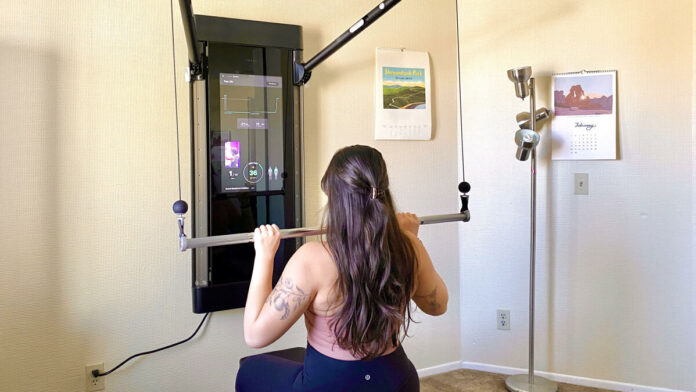In the past, the idea of having a fully functional gym within one’s home seemed like a luxury reserved for the rich and celebrities. Nevertheless, in recent years, the fitness equipment industry has witnessed a remarkable transformation due to technology, making home gyms more accessible and efficient than ever before. This revolution has been fueled by innovations in smart gym equipment, virtual training platforms, and a growing demand for convenient and personalised fitness solutions.
The Changing Concept of Fitness
The fitness landscape has been shifting dramatically over the last decade. Gone are the days when a trip to the local gym was the primary way to stay fit. Today, the fitness industry is experiencing a surge in the popularity of home gyms, and technology is at the forefront of this transformation.
The Tech-Driven Home Gym

Smart Exercise Equipment:
Traditional gym equipment has evolved into intelligent machines equipped with sensors, touch screens, and connectivity features. Smart treadmills, stationary bikes, and weightlifting machines have now become home gym equipment to monitor your progress, adjust resistance levels, and sync with fitness apps for real-time data tracking. Brands like Peloton, NordicTrack, and Mirror are leading the way in this category.
Virtual Reality Workouts:
Virtual reality (VR) has entered the fitness scene, offering an immersive workout experience like never before. Users can escape to virtual landscapes while cycling, boxing, or practicing yoga, all from the comfort of their home. VR headsets like Oculus have introduced fitness-specific applications, making workouts more engaging and enjoyable.
AI-Powered Personalisation:
Artificial intelligence (AI) is being integrated into fitness equipment to provide users with personalised workout recommendations. These AI-driven systems consider your fitness goals, track your progress, and adapt routines accordingly. It’s like having a personal trainer at your disposal 24/7. Isn’t that amazing?
Connected Ecosystems:3>
The fitness equipment industry is increasingly emphasising interconnectedness. Smart gym equipment can now sync with your smartphone, fitness apps, and wearable devices. This seamless connectivity allows for better data analysis and enables you to monitor your health and fitness holistically.
The Convenience Factor
One of the main reasons behind the rise of home gyms is the convenience they offer. Here’s how technology is making home workouts more accessible:
Time and Location Independence:
With a home gym, you can work out at any time that suits your schedule, without travelling to a gym. Technology has enabled on-demand fitness classes and live streaming workouts, providing flexibility like never before.
Privacy and Comfort:
Some people feel self-conscious or uncomfortable working out in public gyms. Home gyms provide a private and judgment-free environment, encouraging more individuals to embrace fitness.
Customisation:
Home gyms allow users to create their ideal workout environment. You can choose the equipment that matches your fitness goals and preferences, rather than relying on whatever is available at a commercial gym.
Family-Friendly:
Home gyms are family-friendly. Parents can set a positive example for their children and promote a healthy lifestyle by exercising together at home. Some smart equipment even offers family accounts, making it easier for everyone to track their progress.
The Impact on the Fitness Industry

The rise of home gyms and technology-driven fitness solutions is reshaping the entire fitness industry:
Changing Business Models:
Traditional fitness centers are adapting to the changing landscape by offering virtual classes and equipment rental options. This shift reflects a growing demand for flexible fitness solutions.
Market Growth:
The global fitness equipment market is experiencing substantial growth. Technological advancements have expanded the market beyond gym enthusiasts to a broader audience of health-conscious individuals.
Competition and Innovation:
As technology evolves, competition in the fitness equipment industry is fiercer than ever. Manufacturers are constantly innovating to offer cutting-edge solutions, leading to a healthier and more dynamic marketplace.
Fitness Accessibility:
Technology is making fitness more accessible to people with limited mobility or those living in remote areas. Virtual training and smart equipment provide opportunities for a diverse range of individuals to embrace an active lifestyle.
Challenges and Considerations

While the rise of home gyms is undoubtedly exciting, there are some challenges and considerations to keep in mind:
Cost:
High-tech home gym equipment can come with a hefty price tag. However, for many, the investment is seen as a long-term commitment to their health and well-being.
Maintenance:
Smart equipment requires maintenance and occasional updates. Users should factor in maintenance costs and warranties when purchasing these products.
Motivation:
Some individuals thrive in a gym environment with instructors and fellow exercisers. Staying motivated at home may be more challenging for them, and they may miss the social aspects of working out in a group.
Space:
Home gyms require space, and not everyone has the room to accommodate extensive equipment. Innovative, space-saving designs are emerging to address this issue.
Conclusion
The fitness equipment industry is in the midst of a technology-driven transformation, with the rise of home gyms at its core. As technology continues to develop, home workouts are becoming more convenient, engaging, and personalised than ever before. This trend is reshaping the fitness landscape, making exercise accessible to a broader audience and leading them into the future of fitness.
Whether you’re a fitness enthusiast or just looking for a convenient way to stay active, the fusion of technology and fitness equipment is opening up a world of possibilities within the comfort of your own home. Embrace the future of fitness, and start your journey towards a healthier, more active lifestyle today.







